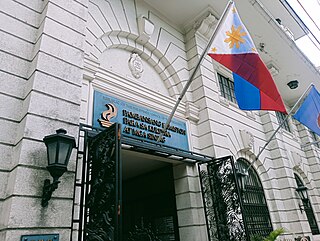
The Archdiocesan Shrine of Our Lady of Consolation and Cincture, also known as the Church of Saint Augustine and Immaculate Conception Parish, is a Roman Catholic church under the auspices of the Order of Saint Augustine located inside the historic walled city of Intramuros in Manila, Philippines. Completed in 1607, it is the oldest stone church in the country.

PLDT, Inc., formerly known as the Philippine Long Distance Telephone Company, is a Philippine telecommunications, internet and digital service company.

The Rizal Memorial Sports Complex is a national sports complex of the Philippines, located on Pablo Ocampo St., Malate, Manila. It is named in honor of the country's national hero, José Rizal (1861–1896). The complex is currently managed by the Philippine Sports Commission, while the property is owned by the Manila City government. The complex also houses the administrative office of the PSC, and quarters for the Philippines' national athletes.

The National Commission for Culture and the Arts of the Philippines is the official government agency for culture in the Philippines. It is the overall policy making body, coordinating, and grants giving agency for the preservation, development and promotion of Philippine arts and culture; an executing agency for the policies it formulates; and task to administering the National Endowment Fund for Culture and the Arts (NEFCA) – fund exclusively for the implementation of culture and arts programs and projects.

The Cultural Center of the Philippines Foundation, Inc. is a government-owned and controlled corporation established to preserve, develop and promote arts and culture in the Philippines. The CCP was established through Executive Order No. 30 s. 1966 by President Ferdinand Marcos. Although an independent institution of the Philippine government, it receives an annual subsidy and is placed under the National Commission for Culture and the Arts for purposes of policy coordination. The CCP is headed by an 11-member Board of Trustees, currently headed by Chairperson Margarita Moran-Floirendo. Its current president is Arsenio Lizaso.

The Ayala Museum is a museum in Makati, Metro Manila, Philippines. It is run privately by the Ayala Foundation and houses archaeological, ethnographic, historical, fine arts, numismatics, and ecclesiastical exhibits. Since its establishment in 1967, the museum has been committed to showcasing overseas collections and situating contemporary Philippine art in the global arena in a two-way highway of mutual cooperation and exchange with local and international associates. The museum was reopened on December 4, 2021, after a two-year renovation.

Leandro Valencia Locsin, Sr., also known by the initials LVL and the nickname "Lindy", was a Filipino architect, artist, and interior designer known for his use of concrete, floating volume and simplistic design in his various projects. An avid collector, he was fond of modern painting and Chinese ceramics. He was proclaimed a National Artist of the Philippines for Architecture in 1990 by the late President Corazon C. Aquino.

Saint Scholastica's College, also referred to by its acronym SSC or colloquially St. Scho, is a private Catholic basic and higher education institution for women founded and managed by the Congregation of the Missionary Benedictine Sisters of Tutzing in a 3.66 hectares (36,600 m2) lot in Malate, Manila, Philippines. It was established in 1906 initially offering elementary academic programs. It started admitting high school students in 1907 and opened its collegiate department in 1920. It pioneered in formal music education in the Philippines, opening a Conservatory of Music in 1907.

The Rizal Memorial Coliseum is an indoor arena in the Rizal Memorial Sports Complex in Manila, Philippines. It can hold up to 6,100 people.

Greenbelt, also known as Ayala Malls Greenbelt, is a shopping mall located at Ayala Center, Makati, Metro Manila, Philippines. It is owned by Ayala Malls, a real-estate subsidiary of Ayala Land, which is an affiliate of Ayala Corporation. It opened in 1988 after merging existing structures and is one of the Ayala Corporation's flagship projects. The mall offers a mix of high-end retail shops, restaurants, amenities, leisure and entertainment. Currently, the mall has five sections: two enclosed areas, two buildings with open-air shopping areas, and Greenbelt 5, which was opened in 2007.

The Philippine Registry of Cultural Property, abbreviated as PRECUP, is a national registry of the Philippine Government used to consolidate in one record all cultural property that are deemed important to the cultural heritage, tangible and intangible, of the Philippines. On June 11, 2018, the entries in the newly updated PRECUP was at 3,921. Additionally, 1,259 out of 1,715 LGUs, or 73 percent of LGUs have established local cultural inventories (LCI).

Ancestral houses of the Philippines or Heritage Houses are homes owned and preserved by the same family for several generations as part of the Filipino family culture. It corresponds to long tradition by Filipino people of giving reverence for ancestors and elders. Houses could be a simple house to a mansion. The most common ones are the "Bahay na Bato". Some houses of prominent families had become points of interest or museums in their community because of its cultural, architectural or historical significance. These houses that are deemed of significant importance to the Filipino culture are declared Heritage House by the National Historical Commission of the Philippines (NHCP), previously known as the National Historical Institute (NHI) of the Philippines. Preservation is of utmost importance as some ancestral houses have come into danger due to business people who buy old houses in the provinces, dismantle them then sell the parts as ancestral building materials for homeowners wishing to have the ancestral ambiance on their houses. These ancestral houses provide the current generation a look back of the country's colonial past through these old houses.

BusinessWorld is a business newspaper in the Philippines with a nationwide circulation of more than 117,000. Founded in 1967 as Business Day, it is Southeast Asia's first daily business newspaper.

The Mandarin Oriental Manila was a hotel along Makati Avenue in Makati, Metro Manila, Philippines, managed by the Mandarin Oriental Hotel Group and designed by National Artist Leandro Locsin.

The Embassy of the Philippines in Tokyo is the diplomatic mission of the Republic of the Philippines to Japan. Opened in 1944 as the first embassy established by a Philippine government, it is currently located in the Roppongi district of Tokyo's Minato ward, near the Roppongi Hills development.

The National Museum of Natural History is the national natural history museum of the Philippines. It is located along Agrifina Circle in Rizal Park, Manila.

The Cultural Center of the Philippines Complex, also known as the CCP Complex, is an 88-hectare (220-acre) art district managed by the Cultural Center of the Philippines (CCP) located along Roxas Boulevard in Metro Manila, Philippines. It is a mixed-use cultural and tourism hub overlooking Manila Bay in south-central Manila, most of which fall under the jurisdiction of the city of Pasay.

The old BDO Corporate Center Makati, formerly the PCI Bank Towers, was a two-skyscraper complex in Makati, Metro Manila, Philippines.


















